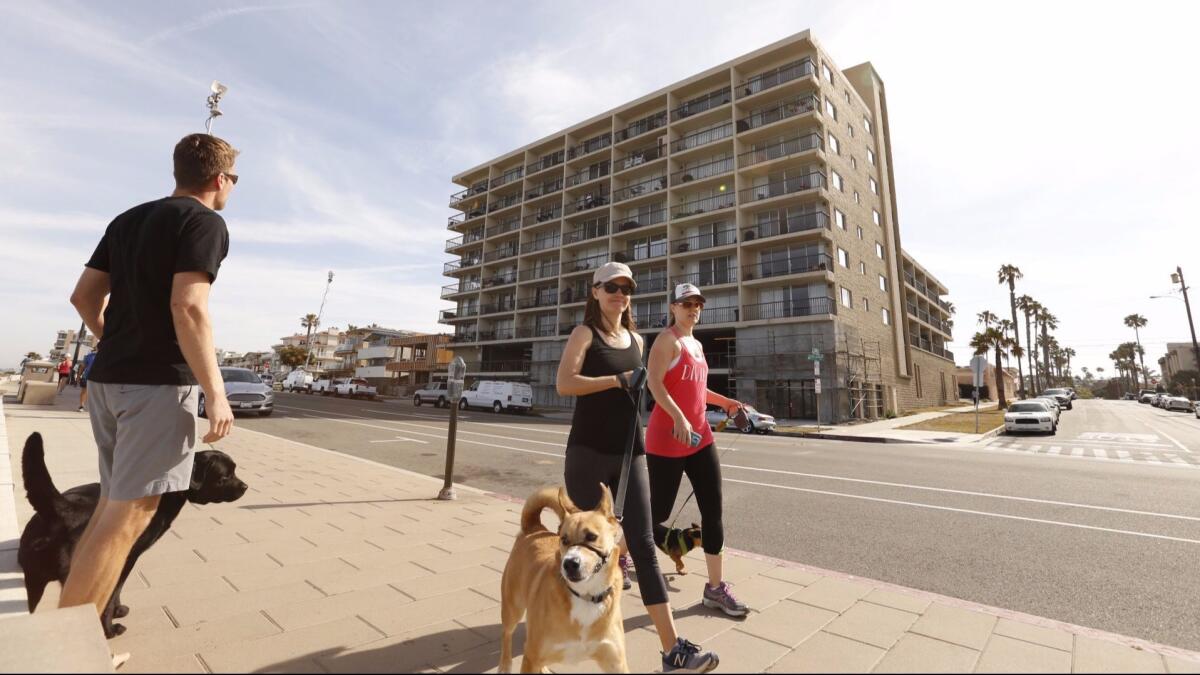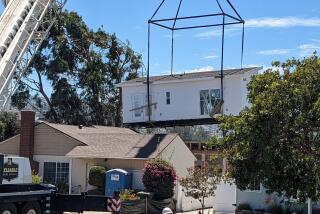Redondo Beach halts mixed-use developments after residents raise concerns about traffic

The Redondo Beach City Council has placed a nearly one-year moratorium on mixed-use development, a move that comes amid a statewide housing shortage driving up rents and home prices.
The 10½-month ban, which passed unanimously Tuesday evening, puts a brake on projects that combine retail and office with housing — and are going up in many communities to the dismay of residents concerned over traffic.
“When is enough enough?” said Bruce Szeles, a member of the Redondo Beach community group Save the Riviera. “Trying to get around here after work to pick up the kids from school is just crazy.”
The City Council’s action extended a 45-day moratorium passed in August for an additional 10½ months. In doing so, the council found that more mixed-use projects would have an adverse effect on traffic and thus “public health or safety.”
The timeout is meant to give the city breathing room to hammer out new rules for its mixed-use zones that would lessen the impact on schools, infrastructure and city services. Next year, the council will have the opportunity to extend the moratorium for an additional year.
The city of roughly 68,900 residents has about 30,700 homes, according to data from the state Department of Finance. And an additional 3,296 housing units could be built in Redondo Beach’s “mixed-use commercial/residential zones,” according to the city’s road map for housing development in its general plan.
However, it’s unclear how many of those would be affected by the moratorium, which does not cover construction in residential zones, nor previously approved projects. The planned redevelopment of the South Bay Galleria into a mixed-use center with retail and housing also would not be affected because it is located in a specialty zone.
Sean Scully, Redondo Beach’s planning manager, did not respond to an email asking for clarification.
The decision Tuesday is the latest example of a debate raging in Southern California, as residents and politicians decide whether to place more of an emphasis on preserving the character of communities or expanding the housing supply.
According to an analysis from Harvard University’s Joint Center for Housing Studies, in 2015 some 42% of Californians spent more than 30% of their income on housing — a threshold when costs are said to become a burden.
In Redondo Beach, the median apartment rent was $3,423 a month in July, while the median home price hit $1 million, according to real estate website Zillow.
“It goes to the underlying problem — everyone wants someone else to build housing,” said Christopher Thornberg, founding partner of Beacon Economics. “It’s all well and good, just don’t build it anywhere near me.”
The debate has been driven by the desire of many residents to retain the suburban lifestyle they grew up in or bought into years ago.
But with vacant land increasingly rare in coastal counties, often the only opportunity to increase the supply of housing is to build denser development — an unappealing prospect for many residents in areas already clogged with traffic.
Redondo Beach is not the first city to pass a moratorium, an aggressive planning tool that was used back in the 1980s, another time of rapid apartment development.
Back then, a number of smaller cities passed building moratoriums — including Glendale, where it sparked litigation by developers opposed to it.
More recently, in March, Los Angeles voters rejected a two-year ban on projects that needed zone changes following a debate over density and housing affordability.
In Redondo Beach, contentious projects have included a 180-unit apartment and retail project known as Legado Redondo.
Proposed in 2015, the project in south Redondo Beach spurred backlash from neighbors and led to the launch of a group named Save the Riviera. Last year, the city ultimately approved a smaller 115-unit project.
The developer, Legado Cos. of Beverly Hills, sued, and the City Council on Tuesday reached a tentative deal that would involve slightly trimming the commercial space and retaining the 115 units.
In May, Nils Nehrenheim, a leader of Save the Riviera, won a seat on the City Council, tipping the balance of power toward slow-growth activists, according to an article at the time in the local paper, the Daily Breeze.
When the council unanimously passed the initial 45-day moratorium, Mayor Bill Brand — also elected this year on a slow-growth platform — said he had been concerned about mixed-use for some time.
He pointed to a project with 435 condos that was proposed last decade for Torrance Boulevard. The development, he said, was reduced to 189 units after residents pushed back against any residential units on the site.
“It just went from there,” he told those in attendance at the City Council meeting in August.
Brand cited concerns that developments with new housing don’t generate enough in tax revenue to pay for city services and that mixed use is a sign of “overdevelopment, a sign of change of character of a neighborhood.”
“Residential development doesn’t really pay in Redondo Beach,” he said at the meeting. “Redondo does not have a housing shortage, and the crisis we do have really is a traffic crisis and an on- and off-again water crisis.
“And if we continue with a lot of this addition of residential soon we will have school overcrowding,” he added.
Many economists agree that residential development does not pay for itself in California — a function of Proposition 13, which limits property taxes. But they disagree with Brand’s take on the housing shortage.
They say the housing market is regional and for decades coastal counties have built too few homes relative to their population and job growth.
And as home building lagged, prices and rents have surged amid heavy demand to live in an area with mild weather, attractions and a plethora of jobs. Economists say the lack of home building in high-demand communities has pushed people into cheaper neighborhoods or into inland areas, driving up costs there as well.
Redondo Beach is typical of the pace of construction in many communities. From 2006 to 2014, the city added only 41% of the housing units regional authorities deemed sufficient to meet demand, according to permit data.
Thornberg, the economist, said the city’s moratorium is entirely rational if the decision is based only on a desire to control growth and city spending within Redondo Beach.
“But if we all do that, what happens?” he said.
Follow me @khouriandrew on Twitter
UPDATES:
4:15 p.m.: This article was updated with information about a tentative settlement the City Council has reached regarding the Legado Redondo project.
This article was originally published at 5 a.m.
More to Read
Inside the business of entertainment
The Wide Shot brings you news, analysis and insights on everything from streaming wars to production — and what it all means for the future.
You may occasionally receive promotional content from the Los Angeles Times.











